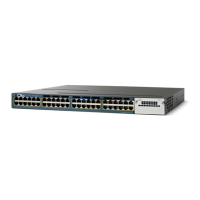1-5
Catalyst 3750-X and 3560-X Switch Software Configuration Guide
OL-25303-03
Chapter 1 Configuring Fallback Bridging
Configuring Fallback Bridging
To remove a bridge group, use the no bridge bridge-group global configuration command. The no
bridge bridge-group command automatically removes all SVIs and routes ports from that bridge group.
To remove an interface from a bridge group and to remove the bridge group, use the no bridge-group
bridge-group interface configuration command.
This example shows how to create bridge group 10, to specify that the VLAN-bridge STP runs in the
bridge group, to define a port as a routed port, and to assign the port to the bridge group:
Switch(config)# bridge 10 protocol vlan-bridge
Switch(config)# interface gigabitethernet3/0/1
Switch(config-if)# no switchport
Switch(config-if)# no shutdown
Switch(config-if)# bridge-group 10
This example shows how to create bridge group 10 and to specify that the VLAN-bridge STP runs in the
bridge group. It defines an SVI for VLAN 2 and assigns it to the bridge group:
Switch(config)# bridge 10 protocol vlan-bridge
Switch(config)# vlan 2
Switch(config-vlan)# exit
Switch(config)# interface vlan2
Switch(config-if)# bridge-group 10
Switch(config-if)# exit
Adjusting Spanning-Tree Parameters
You might need to adjust certain spanning-tree parameters if the default values are not suitable. You
configure parameters affecting the entire spanning tree by using variations of the bridge global
configuration command. You configure interface-specific parameters by using variations of the
bridge-group interface configuration command.
You can adjust spanning-tree parameters by performing any of the tasks in these sections:
• Changing the VLAN-Bridge Spanning-Tree Priority, page 1-6 (optional)
• Changing the Interface Priority, page 1-6 (optional)
• Assigning a Path Cost, page 1-7 (optional)
• Adjusting BPDU Intervals, page 1-7 (optional)
• Disabling the Spanning Tree on an Interface, page 1-9 (optional)
Note Only network administrators with a good understanding of how switches and STP function should make
adjustments to spanning-tree parameters. Poorly planned adjustments can have a negative impact on
performance. A good source on switching is the IEEE 802.1D specification. For more information, see
the “References and Recommended Reading” appendix in the Cisco IOS Configuration Fundamentals
Command Reference.
Step 5
end Return to privileged EXEC mode.
Step 6
show running-config Verify your entries.
Step 7
copy running-config startup-config (Optional) Save your entries in the configuration file.
Command Purpose

